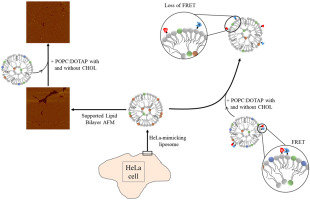Engineering and development of model lipid membranes mimicking the HeLa cell membrane.
Cells are complex systems whose interaction with nanocarriers, i.e., liposomes, are continuously under investigation to improve drug uptake. Model membranes can facilitate the understanding of the processes involved in fusion or endocytosis. In this work, we engineered two different lipid model membranes, vesicles and supported lipid bilayers (SLBs), mimicking the lipid composition of the HeLa cell plasma membrane. We characterized the model using atomic force microscopy (AFM) and fluorescence. We found that liposomes formed with four lipid components mimicking the HeLa cell bilayer show a liquid ordered fluid nature between 13 °C and 34 °C and yield featureless SLBs onto mica. We evaluated the fusion between the model and liposomes positively charged with and without cholesterol by AFM-based force spectroscopy and fluorescence techniques, such as Förster resonance energy transfer, fluorescence lifetime decay and fluorescence anisotropy. The results indicated a primary electrostatic interaction between the HeLa bilayer model and the liposomes. It was also confirmed the well-known fact that cholesterol enhances the fusion process with the engineered HeLa bilayer. All results support the usefulness of the engineered model in the rationale design of liposomes for drug delivery.


